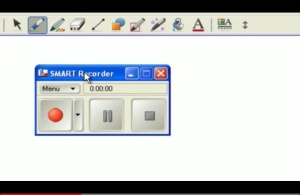Wednesday has become my dedicated SMART Board Exploration Day in my classroom. Though I spend time with it during other times as well, with my newsletter published for the week and my teammate in a weekly mentoring meeting, I find myself with 50 (usually) uninterrupted minutes of time to improve my facility with the SMART Board. This week I wanted to be ready for my math class and prepare for our summative assessment using SMART Notebook. Knowing how to perform a skill and actually executing it in context are two different ideals, so I used my time to explore the functions of the SMART Notebook software as they relate to math assessment.
Referencing the videos I’ve watched previously, I walked through the initial stages of preparing a notebook. Working through those tutorials, I was able to develop a new notebook containing the week’s warm-ups. To this point I have taken advantage of YouTube tutorials from one primary source, Fuse School. It seems counter-intuitive, but because my focus is more specific now and narrowed in scope, tailored to creating a SMART Notebook for warm-ups to use for formative assessment, I am branching out as I search for further information and my sources have, in fact, expanded in scope. One helpful tool I discovered to enhance my assessment notebook was the SMART Recorder. Since our current focus is on solving expanded addition and subtraction problems, I could see value in being able to record multi-step processes for future student viewing, so I searched for a helpful tutorial and I found several. Here is one of the most helpful:
http://www.youtube.com/watch?v=X9qiH-jAq-Q
I found myself stopping and starting, stopping and restarting the video in order to solidify both my understanding of how to use the tool and how it might be useful in my math class. I was reminded of the district’s instruction model, the Gradual Release Model. As I reflect on this type of learning, I realize now I found myself intermittently on different points of the continuum of direct instruction, guided practice, collaboration, and independence. Even though I was learning this new skill by myself, I required differing frequency and intensity of instruction from the video.
Through this experience, I was able to develop greater empathy for my students, who move fluidly among the four phases to learn new concepts every day. The SMART Notebook can be created and saved for future use when students are not actually at school. One of the most significant benefits this notebook has for students is that it serves as both a) a catalyst for collecting data about student understanding of core math skills and b) an opportunity for me to maximize my time with students by conferring with them about the daily formative assessments in the math workshop format. That’s powerful because it enables students to solve problems and receive feedback almost immediately; without the board I wouldn’t have the expedient feedback loop that both encourages students to examine their learning process and adapt it as necessary and affirms their work, motivating them to embrace the next challenge.
